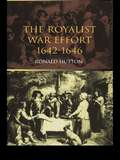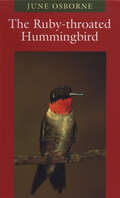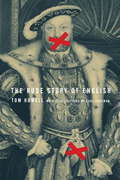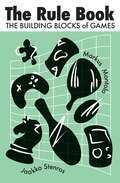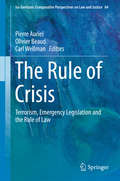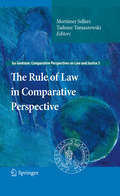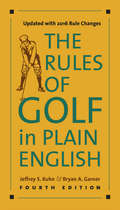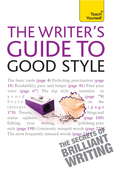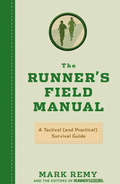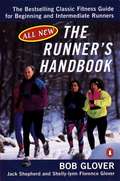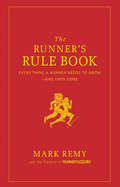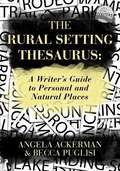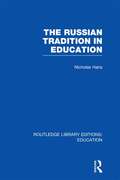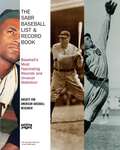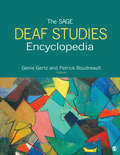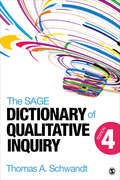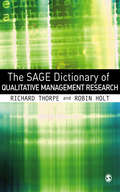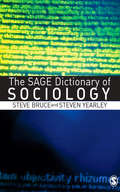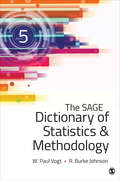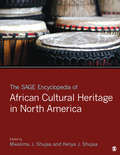- Table View
- List View
The Royalist War Effort: 1642-1646
by Ronald HuttonIn this reissue of the second edition of The Royalist War Effort, 1642-1646 Ronald Hutton places his vivid account of the Royalist War effort in modern historical context, bringing the reader up to date with recent developments in the study of the English Civil War. He analyzes the influences which affected his own interpretation of events, ensuring that The Royalist War Effort, 1642-1646 remains the most informative and compelling account of the Royalist experience in the English Civil War.
The Ruby-throated Hummingbird (Corrie Herring Hooks Series)
by June OsborneIn this invitingly-written book, June Osborne paints a fully detailed portrait of perhaps the best-known hummingbird in the United States, the ruby-throat. There is no mistaking a hummingbird. Even people who hardly know a robin from a sparrow recognize that flash of iridescent feathers and the distinctive hovering flight. So popular have &“hummers&” become that even casual birdwatchers now travel great distances to hummingbird hot spots to see masses of birds in their annual migrations. Drawing from her own birdwatching experiences, June Osborne offers an &“up close and personal&” look at a female ruby-throat building her nest and rearing young, as well as an account of a day in the life of a male ruby-throat and stories of the hummers&’ migrations between their summer breeding grounds in the United States and Canada and their winter homes in Mexico and Central America. In addition to this life history, Osborne recounts early hummingbird sightings and tells how the bird received its common and scientific names. After an overview of hummingbirds&’ distinctive ways of feeding, flying, and conserving energy, she offers a detailed description of the ruby-throat that will help you tell females from males, immature birds from adults, and ruby-throats from similar species. Osborne also takes you on a visit to the &“Hummer/Bird Celebration!&” at Rockport, reviews hummingbird banding programs, and explains how to attract hummingbirds to your yard or apartment balcony.
The Rude Story of English
by Tom HowellThere are only two problems with the story of the English language: one, no hero. Two, not rude enough. In The Rude Story of English, recovering lexicographer Tom Howell swiftly remedies these and gives us a rousing account of our language - without all the boring bits and with all the interesting parts kept in - and reveals English's boisterous, at times obnoxious, character.From a haphazard beginning in 449 AD, when a legendary, fearsome Germanic warrior named Hengest tripped and fell onto British shores, the real story of English has been rife with accident, physical comedy, phallic monuments, rude behaviour, dubious facts, and an alarming quantity of poetry written by lawyers.Across vast distances of space and time, from the language's origins to its fast-approaching retirement, a moody and miraculously long-lived Hengest voyages to the pubs of Chaucer's London, aboard pirate ships in the north Atlantic, to plantations in Barbados, bookstores in Jamaica, the chilly inlet of Quidi Vidi, Newfoundland, a private men's club in Australia, and beyond.Part Monty Python sketch, part Oxford English Dictionary, The Rude Story of English displays an exuberant love of language and a sharp, anti-authoritarian sense of humour. Entertaining and informative, it looks at English through its most uncomfortable, colourful, and off-putting parts, chronicling the story of the language as it has never been told before.
The Rule Book: The Building Blocks of Games (Playful Thinking)
by Markus Montola Jaakko StenrosHow games are built on the foundations of rules, and how rules—of which there are only five kinds—really work.Board games to sports, digital games to party games, gambling to role-playing games. They all share one thing in common: rules. Indeed, rules are the one and only thing game scholars agree is central to games. But what, in fact, are rules? In The Rule Book, Jaakko Stenros and Markus Montola explore how different kinds of rules work as building blocks of games. Rules are constraints placed on us while we play, carving a limited possibility space for us. They also inject meaning into our play: without rules there is no queen in chess, no ball in Pong, and no hole in one in golf.Stenros and Montola discuss how rules constitute games through five foundational types: the explicit statements listed in the official rules, the private limitations and goals players place on themselves, the social and cultural norms that guide gameplay, the external regulation the surrounding society places on playing, and the material embodiments of rules. Depending on the game, rules can be formal, internal, social, external, or material.By considering the similarities and differences of wildly different games and rules within a shared theoretical framework, The Rule Book renders all games more legible.
The Rule of Crisis: Terrorism, Emergency Legislation And The Rule Of Law (Ius Gentium: Comparative Perspectives on Law and Justice #64)
by Carl Wellman Pierre Auriel Olivier BeaudThis book analyzes emergency legislations formed in response to terrorism. In recognition that different countries, with different legal traditions, have different solutions, it adopts a comparative point of view. The countries profiled include America, France, Israel, Poland, Germany and United Kingdom. The goal is not to offer judgment on one response or the other. Rather, the contributors offer a comprehensive and thoughtful examination of the entire concept. In the process, they draw attention to the inadaptability of traditional legal and philosophical categories in a new and changing political world. The contributors first criticize the idea of these legislations. They then go on to develop different models to respond to these crises. They build a general analytical framework by answering such questions as: What is an emergency legislation? What kinds of emergencies justify laws of this nature? Why is contemporary terrorism such a specific emergency justifying new laws? Using legal and philosophical reflections, this study looks at how we are changing society. Coverage also provides historical experiences of emergency legislations to further illustrate this point. In the end, readers will gain insight into the long-term consequences of these legislations and how they modify the very work of the rule of law.
The Rule of Law in Comparative Perspective
by Mortimer Sellers Tadeusz TomaszewskiThis new volume on The Rule of Law in Comparative Perspective compares the different conceptions of the rule of law that have developed in different legal cultures. Lawyers and legal scholars from various legal systems describe the social purposes and practical applications of the rule of law, and how it might be improved in the varied circumstances of their own courts and politics. This book will be of interest to lawyers, judges, public officials, and to all those wishing to improve the fundamental structures of their own legal systems, by bringing equal justice to every person subject to the power of the state.
The Rules of Golf in Plain English, Fourth Edition
by Bryan A. Garner Jeffrey S. KuhnThe earliest standards for the game of golf included just 338 words and thirteen rules, which included what to do if your ball had the misfortune of falling into "watery filth" and how to proceed if your ball was stopped by a horse. The official Rules of Golf have since grown to more than 40,000 words and cover everything from marking a scorecard to determining whether a club has the appropriate roughness. Two hundred years of revisions have rendered these Rules opaque and stylistically inconsistent. Those intricacies can be intimidating for anyone hoping to pick up the game and frustrating for longtime players who just want to settle a dispute. Both lawyers and avid golfers, Jeffrey S. Kuhn and Bryan A. Garner recognized the difficulties that the language of the Rules of Golf has created, especially in a sport that expects players to call penalties on themselves. By reworking the Rules line by line, word by word, they have produced an accessible resource that no golfer--from the duffer to the pro--should be without. This new edition of The Rules of Golf in Plain English is fully aligned with the latest United States Golf Association updates and continues to be published with their permission and encouragement. Clear and concise, this reference will allow players to spend more time playing through and less time scratching their heads.
The Rules of Good Style: Teach Yourself
by Katherine LapworthDo you want to write more effectively, correctly and in a manner which is appropriate for this brave new world of text speak and blogging?Whether you are a professional writer, or writing for your profession, a journalist, non-fiction writer, or simply a would-be blogger, you will find essential guidance and the latest style rules in this book.It contains firstly a detailed breakdown of both the rules of grammar, punctuation and spelling and, secondly, a guide to making your work readable, structured and well-paced. Unlike any other style guide, it also sets out the new and evolving rules for 21st century writing such as blogging, chatrooms, and even PowerPoint presentations.
The Runner's Field Manual: A Tactical (and Practical) Survival Guide (Runner's World)
by Editors of Runner's World Mark RemyWhether you run in the city or on trails, in races or just for fun, you'll find The Runner's Field Manual loaded with practical advice and how-to instruction. As funny as it is useful, this volume covers everything from Dealing With Drivers to Toenail Maintenance, and explores in explicit detail.COMMON THREATS • Urban: The Blackberry-transfixed businessman • Suburban: The bored, angry dog • Trail: The mountain biker who has watched too many Mountain Dew commercials SHOES & GEAR • The Reef Knot: The only knot you need to know • Barefoot Running: Crazy? Or just insane? • The Trash Bag Poncho: Three steps to ultra-cheap rainwear RACE DAY CHALLENGES • Finding the Damn Thing: Not always so easy • Navigating the Aid Station: Pinch the cup • Finish Line Vomit: Hey, it happens Full of charts, illustrations, and more than a few laughs, The Runner's Field Manual is the perfect reference for anyone who loves to run--or wants to learn how.
The Runner's Handbook
by Shelly-Lynn Florence Glover Bob Glover Jack ShepherdFor both runners entering that first neighborhood race and elite marathoners, trainers Bob and Shelly-lynn Florence Glover's completely revised guide is the book on training to compete. A book that's already sold close to 200,000 copies, The Competitive Runner's Handbook will now offer all the latest information needed to design basic training programs; special workouts to increase strength, endurance, and power; schedules and worksheets to develop individual goals; and specifics on preparing for all kinds of races?with an emphasis on the 10K and the marathon. Informed by their over thirty years of coaching experience, the Glovers give winning tips on alternative training, footwear and diet, and common injuries and illnesses, as well as sensible advice on balancing running with work and home life. .
The Runner's Handbook
by Shelly-Lynn Florence Glover Bob Glover Jack ShepherdIf you're a runner, or would like to be one, The Runner's Handbook will answer all your questions. Fitness expert Bob Glover-who has trained thousands of runners-shows you how to devise a training program and keep at the top of your form.
The Runner's Rule Book: Everything a Runner Needs to Know--And Then Some (Runner's World)
by Editors of Runner's World Mark RemyEvery sport has rules. Running is no exception. If you're curious, just visit the Web site of USA Track & Field, the sport's governing body, where you'll find detailed dictates on everything from disqualification to bib-number placement to the caliber of the starter's pistol.But what about the everyday rules of running? The unspoken ones that pertain to the lingo, behavior, and etiquette that every seasoned runner seems to know and every newbie needs to learn? Veteran runner Mark Remy and the editors of Runner's World magazine provide answers to these very questions and many more in The Runner's Rule Book.With 100+ rules that cover the basics of running, racing, track etiquette, and apparel and gear, including hilarious running commentary on running culture, The Runner's Rule Book will be the reference guide you'll turn to again and again for answers to your burning running questions.
The Rural Setting Thesaurus: A Writer's Guide to Personal and Natural Places
by Angela Ackerman Becca PuglisiWithin the pages of a book exists a world drawn from a writer’s deepest imaginings, one that has the ability to pull readers in on a visceral level. But the audience’s fascination will only last if the writer can describe this vibrant realm and its inhabitants well. The setting achieves this by offering readers a unique sensory experience. So much more than stage dressing, the setting can build mood, convey meaning through symbolism, drive the plot by creating challenges that force the hero to fight for what he wants, and trigger his emotions to reveal his most intimate feelings, fears, and desires.
The Russian Tradition in Education (Routledge Library Editions: Education)
by Nicholas HansThis volume describes the Russian tradition in education and in particular the dominant role of Russian nationality. The whole history of Russian education is covered from Peter the Great to Khruschev.
The Ryder Cup: Golf's Greatest Event
by Tom Clavin Bob BubkaRevised and updated, this in-depth look recounts The Ryder Cup's rich history and venerated place in sports, its champions and its characters, and its status as golf's greatest grudge match. From its humble origins in 1927 to its place today as golf's most gentlemanly battle—and a multi-million-dollar international sports event—The Ryder Cup has cemented its place in both its legacy and lore. Golf journalist Tom Clavin and golf commentator Bob Bubka have now made current their seminal work on the tournament, exploring the history and the rivalries, the extraordinary triumphs and devastating defeats, and the U.S. and the European contingents who have made this contest so remarkable. The names are legendary for any fan of golf: Palmer, Nicklaus, Jacklin, Floyd, Mickelson, Ballesteros, Faldo, Hogan, Nelson, Watson, Strange, Sarazen, Crenshaw, Woods, Montgomerie…the list goes on, as do their pitched battles for dominance and accomplishments on the greens. This up-close and personal look at The Ryder Cup is a must-read for golf fans, especially in preparation for the landmark 40th Anniversary tournament in Gleneagles, Scotland, in 2014.
The SABR Baseball List & Record Book
by Lisa HochsteinFrom the authority on baseball research and statistics comes a vast and fascinating compendium of unique baseball lists and records. The SABR Baseball List & Record Book is an expansive collection of pitching, hitting, fielding, home run, team, and rookie records not available online or in any other book. This is a treasure trove of baseball history for statistically minded baseball fans that's also packed with intriguing marginalia. For instance, on July 25, 1967, Chicago's Ken Berry ended Game Two of a doubleheader against Cleveland with a home run in the bottom of the sixteenth inning -- Chicago's second game-winning homer of the day. The comprehensive lists include Most Career Home Runs by Two Brothers (Tommie and Hank Aaron have 768), Most Seasons with 15 or More Wins (Cy Young and Greg Maddux each have 18), and Highest On Base Percentage in a Season by a Rookie (listing every rookie above . 400). Unlike other record books that only list the record holders -- say, most RBI by a rookie, held by Ted Williams with 145 -- SABR details every rookie to reach 100 RBI. Other record books might note the last pitcher in each league to steal home; here SABR has included every pitcher to do it. The book also includes a number of idiosyncratic features, such as a rundown of every player who has hit a triple and then stolen home, or every reliever who has won two games in one day. Many of the lists include a comments column for key historical notes and entertaining trivia (Bob Horner hit four home runs in a 1986 game, but his team lost). This is a must-have for every fan's library. Edited by Lyle Spatz, Chairman of the Baseball Records Committee for SABR.
The SAGE Deaf Studies Encyclopedia
by Genie Gertz Dr Patrick BoudreaultThe time has come for a new in-depth encyclopedic collection of articles defining the current state of Deaf Studies at an international level and using the critical and intersectional lens encompassing the field. The emergence of Deaf Studies programs at colleges and universities and the broadened knowledge of social sciences (including but not limited to Deaf History, Deaf Culture, Signed Languages, Deaf Bilingual Education, Deaf Art, and more) have served to expand the activities of research, teaching, analysis, and curriculum development. The field has experienced a major shift due to increasing awareness of Deaf Studies research since the mid-1960s. The field has been further influenced by the Deaf community’s movement, resistance, activism and politics worldwide, as well as the impact of technological advances, such as in communications, with cell phones, computers, and other devices. A major goal of this new encyclopedia is to shift focus away from the “Medical/Pathological Model” that would view Deaf individuals as needing to be “fixed” in order to correct hearing and speaking deficiencies for the sole purpose of assimilating into mainstream society. By contrast, The Deaf Studies Encyclopedia seeks to carve out a new and critical perspective on Deaf Studies with the focus that the Deaf are not a people with a disability to be treated and “cured” medically, but rather, are members of a distinct cultural group with a distinct and vibrant community and way of being.
The SAGE Deaf Studies Encyclopedia
by Genie Gertz Dr Patrick BoudreaultThe time has come for a new in-depth encyclopedic collection of articles defining the current state of Deaf Studies at an international level and using the critical and intersectional lens encompassing the field. The emergence of Deaf Studies programs at colleges and universities and the broadened knowledge of social sciences (including but not limited to Deaf History, Deaf Culture, Signed Languages, Deaf Bilingual Education, Deaf Art, and more) have served to expand the activities of research, teaching, analysis, and curriculum development. The field has experienced a major shift due to increasing awareness of Deaf Studies research since the mid-1960s. The field has been further influenced by the Deaf community’s movement, resistance, activism and politics worldwide, as well as the impact of technological advances, such as in communications, with cell phones, computers, and other devices. A major goal of this new encyclopedia is to shift focus away from the “Medical/Pathological Model” that would view Deaf individuals as needing to be “fixed” in order to correct hearing and speaking deficiencies for the sole purpose of assimilating into mainstream society. By contrast, The Deaf Studies Encyclopedia seeks to carve out a new and critical perspective on Deaf Studies with the focus that the Deaf are not a people with a disability to be treated and “cured” medically, but rather, are members of a distinct cultural group with a distinct and vibrant community and way of being.
The SAGE Dictionary of Qualitative Inquiry (Fourth Edition)
by Thomas A. SchwandtIn this Fourth Edition of The SAGE Dictionary of Qualitative Inquiry Thomas A. Schwandt provides a guide to the terms and phrases that help shape the origins, purpose, logic, meaning, and methods of the practices known as qualitative inquiry. This edition features 20 additional terms as well as a restructured Reader’s Guide. Key references have been updated and select terms and phrases from previous editions have been reorganized and greatly expanded. Together, the dictionary entries provide a guide to the methodological and epistemological concepts and theoretical orientations of qualitative inquiry. This one-of-a-kind resource is ideal for readers who are navigating various perspectives on qualitative inquiry, working on a qualitative dissertation, or are launching their own investigations into the issues covered.
The SAGE Dictionary of Qualitative Management Research
by Robin Holt Richard Thorpe'This comprehensive work extends general ideas, concepts, and techniques of qualitative research into the realm of management research...This is a crucial reference tool for anyone conducting research in this field of study' - CHOICE With over 100 entries on key concepts and theorists, the Dictionary of Qualitative Management Research provides full coverage of the field, explaining fundamental concepts and introducing new and unfamiliar terms. This book provides: - Definitions - Examples in the field of management studies - Criticisms and possible future directions Engagingly written by specialists in each area, this dictionary will be the definitive and essential companion to established textbooks and teaching materials in qualitative management research.
The SAGE Dictionary of Sociology
by Steve Bruce Steven Yearley"Undoubtedly the most accessible, readable and downright interesting - even amusing - dictionary of its type. In being all of those things - and more - the dictionary does not sacrifice on quality. There are many well-chosen entries and they are quite informative. A useful addition to any scholar's library while at the same time being an excellent resource for both graduate and undergraduate students" - George Ritzer, University of Maryland "This is a delightful and comprehensive dictionary. The authors write in an engaging and lively style that brings alive the ideas of sociology not only for existing practitioners, but also for a whole new generation of students" - Tim May, University of Salford With over 1000 entries on key concepts and theorists, The SAGE Dictionary of Sociology provides full coverage of the field, clarifying the technical use of apparently common words, explaining the fundamental concepts and introducing new and unfamiliar terms. This book provides: authoritative, reliable definitions accessible 'digests' of key arguments contemporary, appealing illustrations of points readability. This is not just another dry guide to the discipline. Engagingly written with its audience firmly in mind, it will be the definitive and chosen companion to established textbooks and teaching materials in sociology.
The SAGE Dictionary of Statistics & Methodology: A Nontechnical Guide for the Social Sciences
by Robert Burke Johnson W. (William) VogtWritten in a clear, readable style with a wide range of explanations and examples, this must-have dictionary reflects recent changes in the fields of statistics and methodology. Packed with new definitions, terms, and graphics, this invaluable resource is an ideal reference for researchers and professionals in the field and provides everything students need to read and understand a research report, including elementary terms, concepts, methodology, and design definitions, as well as concepts from qualitative research methods and terms from theory and philosophy.
The SAGE Dictionary of Statistics & Methodology: A Nontechnical Guide for the Social Sciences
by Robert Burke Johnson W. (William) VogtWritten in a clear, readable style with a wide range of explanations and examples, this must-have dictionary reflects recent changes in the fields of statistics and methodology. Packed with new definitions, terms, and graphics, this invaluable resource is an ideal reference for researchers and professionals in the field and provides everything students need to read and understand a research report, including elementary terms, concepts, methodology, and design definitions, as well as concepts from qualitative research methods and terms from theory and philosophy.
The SAGE Encyclopedia of African Cultural Heritage in North America
by Mwalimu J. Shujaa Kenya J. ShujaaThe Encyclopedia of African Cultural Heritage in North America provides an accessible ready reference on the retention and continuity of African culture within the United States. Our conceptual framework holds, first, that culture is a form of self-knowledge and knowledge about self in the world as transmitted from one person to another. Second, that African people continuously create their own cultural history as they move through time and space. Third, that African descended people living outside of Africa are also contributors to and participate in the creation of African cultural history. Entries focus on illuminating Africanisms (cultural retentions traceable to an African origin) and cultural continuities (ongoing practices and processes through which African culture continues to be created and formed). Thus, the focus is more culturally specific and less concerned with the broader transatlantic demographic, political and geographic issues that are the focus of similar recent reference works. We also focus less on biographies of individuals and political and economic ties and more on processes and manifestations of African cultural heritage and continuity. FEATURES: A two-volume A-to-Z work, available in a choice of print or electronic formats 350 signed entries, each concluding with Cross-references and Further Readings 150 figures and photos Front matter consisting of an Introduction and a Reader’s Guide organizing entries thematically to more easily guide users to related entries Signed articles concluding with cross-references
The SAGE Encyclopedia of African Cultural Heritage in North America
by Mwalimu J. Shujaa Kenya J. ShujaaThe Encyclopedia of African Cultural Heritage in North America provides an accessible ready reference on the retention and continuity of African culture within the United States. Our conceptual framework holds, first, that culture is a form of self-knowledge and knowledge about self in the world as transmitted from one person to another. Second, that African people continuously create their own cultural history as they move through time and space. Third, that African descended people living outside of Africa are also contributors to and participate in the creation of African cultural history. Entries focus on illuminating Africanisms (cultural retentions traceable to an African origin) and cultural continuities (ongoing practices and processes through which African culture continues to be created and formed). Thus, the focus is more culturally specific and less concerned with the broader transatlantic demographic, political and geographic issues that are the focus of similar recent reference works. We also focus less on biographies of individuals and political and economic ties and more on processes and manifestations of African cultural heritage and continuity. FEATURES: A two-volume A-to-Z work, available in a choice of print or electronic formats 350 signed entries, each concluding with Cross-references and Further Readings 150 figures and photos Front matter consisting of an Introduction and a Reader’s Guide organizing entries thematically to more easily guide users to related entries Signed articles concluding with cross-references
